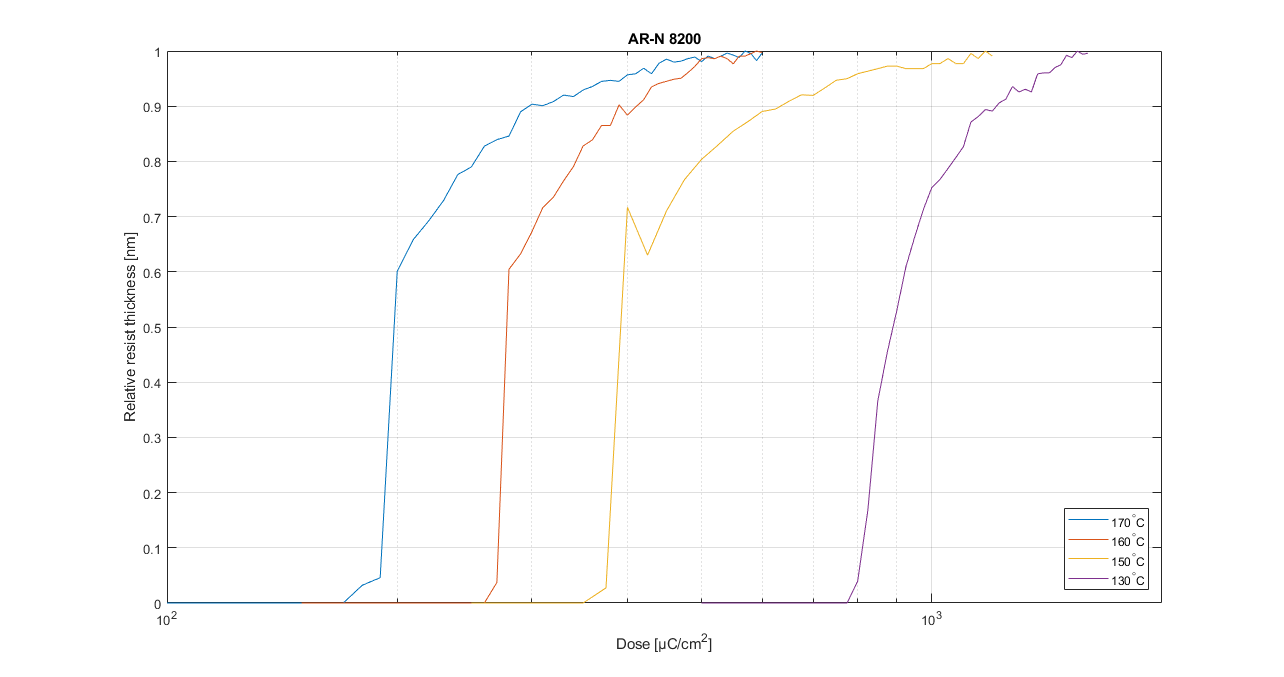Specific Process Knowledge/Lithography/ARN8200
AR-N 8200
AR-N 8200 is a negative E-beam resist from Allresist, it is also known as "Medusa 82". A product presentation from Allresist is available here AR-N8200 presentation.
Allresist also provides these processing guidelines.
Contrast curve @ 100 kV (JEOL 9500)
Exposure dose for AR-N 8200 is very dependent on Post Exposure Bake (PEB) temperature. A contrast curve for four different PEB processes were obtained with the following process parameters.
| AR-N 8200 Contrast Curve, Processed by THOPE, FEB 2022 | ||||
|---|---|---|---|---|
| Resist | Spin Coat | E-beam exposure | PEB | Development |
| AR-N8200.06 | LabSpin 2, 4000 rpm for 60s, softbake 10 min @ 150 degC, thickness is 110 nm | JBX9500, 60 nA, doses 100-1600 µC/cm2, 150 µm x 300 µm rectangles | Labspin 2 hotplate, 130, 150, 160 or 170 degC for 10 min | EBL development fumehood, 60 sec development in AR300-47:DIW (1:1), 30 sec rinse in DIW, nitrogen gun dry |
Hotplate temperatures are assumed surface temperatures based on the 0.90 correction factor in use on the hotplate.
The resulting resist structure height is mapped with Dektak XTa and plotted as a contrast curve below. It is apparent that the dose and contrast is very dependent on the PEB parameters.
Results at 30 kV (Raith eLINE)
A dose test is carried out with the following parameters
| AR-N 8200 30 kV dose test, Processed by THOPE, AUG 2022 | ||||
|---|---|---|---|---|
| Resist | Spin Coat | E-beam exposure | PEB | Development |
| AR-N8200.06 | LabSpin 2, 4000 rpm for 60s, softbake 10 min @ 150 degC, thickness is 120 nm | Raith eLINE Plus, 30 kV, 60 µm aperture, 168 pA | Labspin 2 hotplate 170 degC for 10 min | EBL development fumehood, 60 sec development in AR300-47:DIW (1:1), 30 sec rinse in DIW, nitrogen gun dry |
Area/curved element dose: Fully insoluble dose is around 150-180 µC/cm2.
Line dose: Fully insoluble dose is around 1700 pC/cm.
Dot dose: Fully insoluble dose is around 0.1 pC, this gives a circular diameter of 60 nm. Diameter can be varied by increasing dose, at 0.4 pC diameter is about 100 nm and at 1.2 pC it is about 170 nm.
